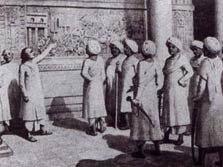

 |  |
 Chola political system was the only one which still maintained contact with the cultivator on a wild scale, and retained characteristics of a centrally organized administration. The political status Rajaraja I was certainly different from that of Amoghavarsha, the Rashtrakuta ruler, or Vishnuvardhana, the Hoysala ruler. The titles used by the Chola kings were Chakrvartigal (or Chakravarti). The royal household was run on an elaborate scale and royal patronage was lavish. The political role of Purohita (priest) as known to northern Indian politics underwent a modification in the Chola system. The Rajguru (priest of the royal family) of the Cholas became a confidant and confessor in addition to being the advisor in all matters temporal and sacred. For further advice there was an assembly of officer whom the king would consult.
Chola political system was the only one which still maintained contact with the cultivator on a wild scale, and retained characteristics of a centrally organized administration. The political status Rajaraja I was certainly different from that of Amoghavarsha, the Rashtrakuta ruler, or Vishnuvardhana, the Hoysala ruler. The titles used by the Chola kings were Chakrvartigal (or Chakravarti). The royal household was run on an elaborate scale and royal patronage was lavish. The political role of Purohita (priest) as known to northern Indian politics underwent a modification in the Chola system. The Rajguru (priest of the royal family) of the Cholas became a confidant and confessor in addition to being the advisor in all matters temporal and sacred. For further advice there was an assembly of officer whom the king would consult.Chola kingdom was divided into provinces (mandalam), their being generally eight or nine of these. Each mandalam was divided into valanadus (or districts). These in turn were subdivided into groups of villages, variously called kurram, nadu, or kottam. Occasionally a very large village would be administered as a single unit and this was called Taniyur. The administrative unit was the village and to that extent there was a little significant difference between Chola administration and that of the Guptas. However, the nature of the village administration was certainly of a very different order. The degree of autonomy at village level was something quiet remarkable for the times. Chola officials participated in village affairs more as advisors and observers than as administrators. The basic assumption in the type of village autonomy emerging at this period was that each village should be administered by the villagers themselves. For the purpose a village assembly was formed, and authority was vested in this assembly. The general assemblies included most of the local residents and were of three categories: the ur consisted of the tax paying residents of an ordinary village; the sabha was restricted to the Brahmans of the village or else was found exclusively in villages gifted to Brahmans; and finally, the nagaram was found more commonly in trade centers. In some villages the ur and the sabha were found together. Very large villages had two urs if this was more convenient for their functioning. The working of these assemblies differed according to local conditions. The ur was open to all male adults of the village but in affect the older members took a more prominent part, some of them forming a small executive body for routine matters. The sabha had the same system and in addition had the power to constitute smaller committees of any size from among its members. next page >> |
Copyright ©2000 indiansaga.info. All rights reserved.
By using this service, you accept that you won't copy or use the data given in this website for any commercial purpose.
The material on indiansaga.info is for informational & educational purpose only.
This site is best viewed at 800 X 600 picture resolution.